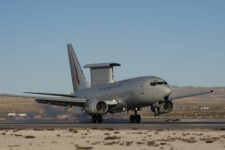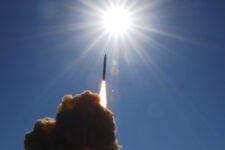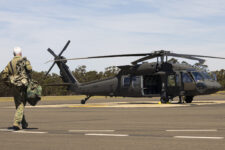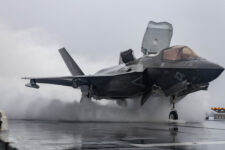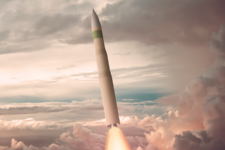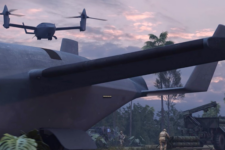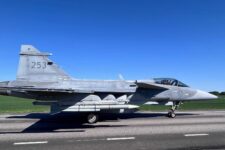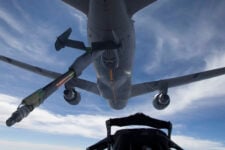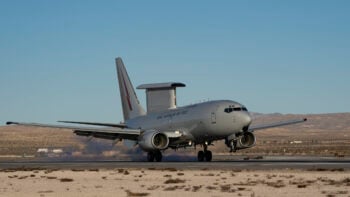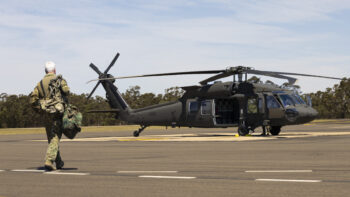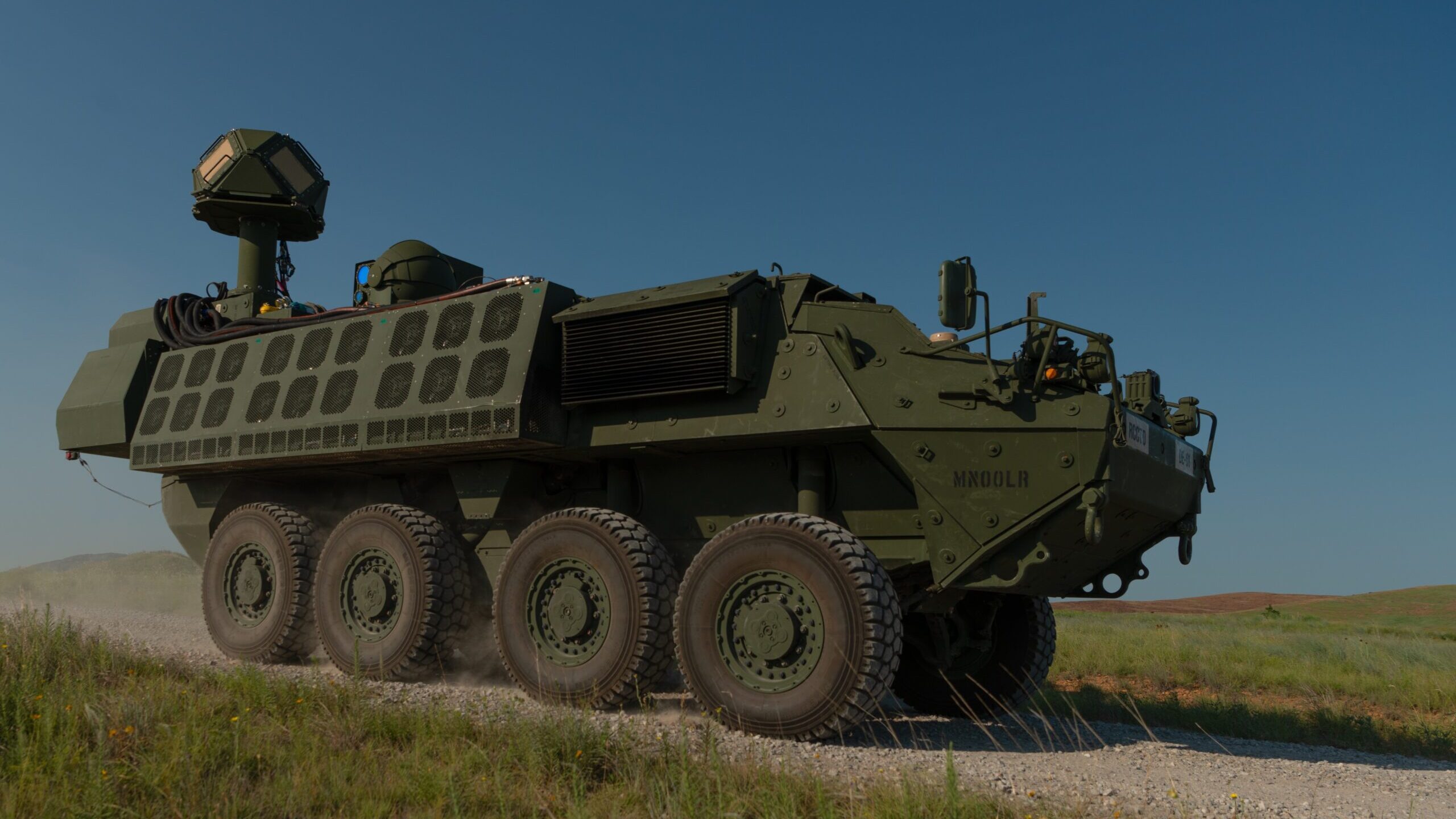
Shown here is a Directed Energy Maneuver-Short Range Air Defense (DE M-SHORAD) prototype. (US Army/ Jim Kendall)
WASHINGTON — Earlier this year the US Army sent four Stryker-mounted 50-kilowatt laser prototypes to the Middle East for soldiers to test out against aerial threats. Initial feedback is rolling in and it’s not overwhelmingly positive, according to Army acquisition head Doug Bush.
“What we’re finding is where the challenges are with directed energy at different power levels,” Bush told members of the Senate Armed Services airland subcommittee on Wednesday. “That [50-kilowatt] power level is proving challenging to incorporate into a vehicle that has to move around constantly — the heat dissipation, the amount of electronics, kind of the wear and tear of a vehicle in a tactical environment versus a fixed site.”
Dubbed the Directed Energy Maneuver Short-Range Air Defense (DE M-SHORAD), the service tasked Kord Technologies with integrating a 50-kilowatt class RTX laser onto a Stryker to down class one to three aerial drones and incoming rockets, artillery and mortars. In total, four prototypes were produced, and Breaking Defense first reported that all four were sent to the US Central Command (CENTCOM) region in February.
Army Vice Chief of Staff Gen. James Mingus said at the time that the goal was to experiment in a live environment complete with weather challenges and dust storms that can alter light particles and degrade beam quality.
“You may have a 50-kilowatt laser, [but] at 10 kilometers can you put at least four kilowatts in a centimeter square because … that’s what you need to burn through a quarter inch steel plate?” the four-star general asked. “But that’s really hard to get … from a big beam to get the small portion of it on the exact spot to be able to burn at that high intensity and any kind of dust particle or that starts to disrupt that.”
Fast forward to today and soldiers are delivering some of that feedback, and Bush said results from the lab environment and test ranges is very different from the tactical environment.
“[Soldiers] will tell you everything and they’re not worried about your feelings,” Bush told senators.
While their initial input is not stellar for those Stryker-based prototypes, other high-energy lasers are proving to be more useful. In late-April, Military.com first reported that the service had also sent a 20-kilowatt Palletized High Energy Laser (P-HEL), overseas.
Bush did not name the P-HEL by name or disclose where it had been deployed, but told lawmakers that those 20-kilowatt class systems “are proving successful” for “some” fixed-site setups. The service has also inked a contract with Lockheed Martin for a 300-kilowatt high energy laser weapon, dubbed the Indirect Fire Protection Capability-High Energy Laser (IFPC-HEL), but that has not yet been delivered to soldiers and tested out, he added.
By The Numbers
The Pentagon has been developing such directed energy weapons for years but is now looking for ways to test them out and get them into the field. That pressure is only growing as the cost of shooting down low-priced drones grows.
At the same time, the Army is grappling with a flat budget next year and opted to make cuts to an array of development coffers, including directed energy one’s.
Even before the DE-MSHORAD soldier feedback came in, Army leaders were planning cuts to that 50-kilowatt laser effort. In its fiscal 2024 budget request, for example, the Army included $110 million for DE M-SHORAD development and laid out a plan to spend nearly $126 million the following year. When the service delivered its FY25 budget request to lawmakers in March, though, it asked for $38 million less than anticipated, or $88 million. And it’s not just a one year cut. Army leaders now plan to spend $445 million between FY26 and FY28 for program development, or about $186 million less than it projected spending last year over the same three-year stint.
Next year’s budget request also takes a swipe at Lockheed Martin’s IFPC-HEL development with the service asking for just under $32 million, a sharp decrease from the $86 million it requested for FY24 and the $209 million it received in FY23. However, it noted that this cut is a natural “progression” as prototypes are delivered and the effort transitions to a program of record.
IFPC High Power Microwave (HPM) research and development also takes a hit. The Army’s FY25 request asks for just over $4 million for next year, $11 million less than requested in FY24 and $41 million fewer dollars than received for FY23. While that development pot is reduced, the service had previously predicted that spending trajectory would decline. (That is, in part, due to this week’s announcement that Epirus has delivered all four IFPC-HPM prototypes to the service.)
As is the case with IFPC-HPM prototype deliveries marking a development milestone, service leaders propose coffer reductions for a variety of reasons, including budget constraints, testing schedules and program transitions out of development and into production. But reductions to the Army’s directed energy portfolios have raised the eyebrows of at least one lawmaker, Sen. Angus King, an Independent from Maine.
During a Senate Armed Services Committee hearing in April, those cuts prompted King to say to Army Secretary Christine Wormuth and Chief of Staff Gen. Randy George, “What in the hell are you people thinking?”
“I’d like to start with three data points: $10,000, $4.3 million and $12,” he said during a Senate Armed Services Committee hearing. “$10,000 is the high-end estimate of cost of the drones that Iran and the Houthis are using, $4.3 million is the cost of one SM-6 missile, $4 million for the Patriot, [and] $12 [is] the cost of the directed energy shot that can take down one of these drones.”
Correction: This story was updated on May 21 with the correct committee Bush testified before.
